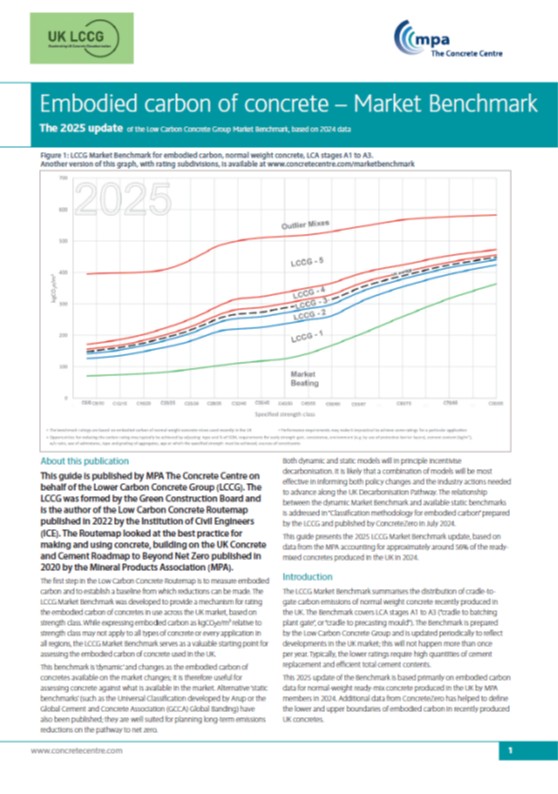Related links
On-demand: Bitesize video
Understand the basics of Environmental Product Declarations, what they contain, how they are used, and what information is currently available from the MPA.
YouTube library

This 12 minute webinar introduces concrete and its constituent materials. It provides insights into how to lower the embodied carbon of concrete through specification.
On-demand: Bitesize video
MPA has been leading work to test a range of low carbon multicomponent cements and cements containing calcined clay.
Concrete Compass: Market benchmarking
Navigating to useful resources and guidance
Figure 1: LCCG Market Benchmark for embodied carbon, normal weight concrete, LCA stages A1 to A3. Another version of this graph, with rating subdivisions, is available further down this webpage.

This Concrete Compass is designed to provide more information on the Low Carbon Concrete Group (LCCG) Market Benchmark, that can inform how designers choose low carbon concretes.
The LCCG Market Benchmark
The LCCG Market Benchmark summarises the distribution of cradle-to-gate carbon emissions of normal weight concrete recently produced in the UK. The Benchmark covers LCA stages A1 to A3 (“cradle to batching plant gate”, or “cradle to precasting mould”). The Benchmark is prepared by the Low Carbon Concrete Group and is updated periodically to reflect developments in the UK market; this will not happen more than once per year. Typically, the lower ratings require high quantities of cement replacement and efficient total cement contents.
The LCCG Benchmark first appeared in the Low Carbon Concrete Routemap published in 2022 by the Institution of Civil Engineers (ICE). The Routemap looked at the best practice for making and using concrete and built on the UK Concrete and Cement Roadmap to Beyond Net Zero published in 2020 by the Mineral Products Association (MPA). The LCCG was formed by the Green Construction Board.
The first step in the Low Carbon Concrete Routemap is to measure carbon and to create a baseline or benchmark. The LCCG Market Benchmark was created to provide a mechanism for rating the embodied carbon of concrete within the range of concretes in use across the market based on strength. Noting that kgCO2/m3 connected to strength is not applicable for all concrete, nor for one concrete application at all times in all regions. However, the current benchmarking exercise can be a starting point with the intention to evolve in the future.
Embodied carbon of concrete: Market Benchmark guide, published by MPA The Concrete Centre on behalf of the LCCG is based on data from the MPA ready-mixed concrete produced in the UK in 2024 and supplemented by data from contractors and independent concrete suppliers. The data was based on a common carbon methodology - gross carbon emission data to EN 15804.
The LCCG Market Benchmark is a tool to assess the embodied carbon of concrete. The tool must be used in the context of reducing overall project and global greenhouse gas (GHG) emissions. Designers should also consider that sometimes a concrete with higher embodied carbon used more efficiently may result in lower project and / or global GHG emissions.
More information
Key guidance
- Specifying Sustainable Concrete - these guides, each focusing on a different constituent part of concrete, assist designers in making effective decisions regarding the design and specification of concrete for a sustainable outcome using BS 8500.
 Back to Concrete Compass main page
Back to Concrete Compass main page
Embodied carbon of concrete: Market Benchmark

This guide presents the 2025 LCCG Market Benchmark update, based on data from the MPA accounting for approximately around 56% of the ready-mixed concretes produced in the UK in 2024.